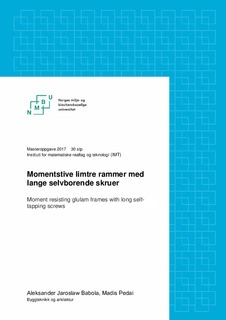| dc.contributor.advisor | Bjørnfot, Anders | |
| dc.contributor.author | Pedai, Madis | |
| dc.contributor.author | Babola, Aleksander Jaroslaw | |
| dc.date.accessioned | 2017-11-07T13:38:50Z | |
| dc.date.available | 2017-11-07T13:38:50Z | |
| dc.date.issued | 2017 | |
| dc.identifier.uri | http://hdl.handle.net/11250/2464694 | |
| dc.description.abstract | Hovedoppgaven i prosjektet har vært å arbeide videre med den tidligere opparbeidete rapporten gjennomført av Bjørnfot et al. (2015) og å teste de forskjellige løsninger i laben. Det var et ønske fra utbyggeren å benytte treverk i størst mulig grad. Dette har resultert i en problemstilling for utforming av momentstive forbindelser mellom tresøyler og limtrebjelker. Disse danner hoved-bæresystemet til deres boliger, slik at man i størst mulig grad kan unngå plasskrevende avstivningssystemer mellom aksene. Momentstive trerammer danner store frie arealer inne i boligene med ev. store glassflater for utsikt og lysforhold. Det finnes mange muligheter for utforming av slike knutepunkter og mange mulige geometrier, men oppgavens omfang har blitt begrenset til noen få interessante løsninger som allerede har vært drøftet i et tidligere oppdrag utført av Bjørnfot et al. (2015). Limtrerammene er hovedsakelig tenkt til å være et alternativ til tradisjonell avstivning med veggskiver. En del av oppgaven har omhandlet dimensjonering av limtrerammene etter NS-EN 1995-1-1 2008. Den andre delen av oppgaven har gått ut på testing av de forskjellige teoretiske løsninger, mens den tredje delen handler om sammenligning av testresultatene med de teoretisk utførte beregninger.
Beregninger er blitt utført i alle tilfeller. Disse inkluderer lastvirkning på søylen, takkonstruksjon og fundament. Beregninger av kapasiteter i de forskjellige knutepunktstilfellene er blitt gjort i PTC Mathcad og Excel iht. respektive Eurokoder og litteratur.
Det ble valgt å vurdere to forskjellige knutepunkter i limtrerammer: knutepunkt mellom søyle og limtrebjelke over 1. etasje og knutepunkt mellom søyle og bjelke over 2. etasje. Det er vurdert forskjellige aspekter rundt knutepunktene, slike som konstruksjonssikkerhet og utførelse.
Gjennomførte beregninger viser at det er mulig å lage momentstive forbindelser ved bruk av limtre for prosjekter omhandlende småhus. Testgjennomføring har ikke bekreftet den teoretiske modellen, noe som åpner veien til videre forskning. | nb_NO |
| dc.description.abstract | The main task of this project has been to continue to work on a previously prepared report carried out by Bjørnfot et al. (2015) and test the various solutions in the lab. It was a request from the developer to use wood as much as possible by using glulam frames as main structure in their buildings. This has resulted in a problem regarding the design of moment resistant connections between glulam columns and beams that form the main bearing system of their catalogue houses and help them to avoid advanced stiffening systems between the axes. Thick wooden frames form large free areas inside the houses and give possibilities for large glass surfaces for the view and light conditions. There are many possibilities for the design of such frames and many possible geometries, but the group has limited the scope to a few interesting solutions that have already been discussed in a previous assignment. The glulam frames are principally intended to be an alternative to traditional stiffening with walls.
The first part of the task has been designing glulam frames according to scientific publications.
The second part of the assignment was testing of the different theoretical solutions. The group came across several execution problems such as predrilling angle or use of powerful machines to set wooden frames together. This has resulted in small failures while execution.
The final part has been to evaluate the calculation model and the real test results. Calculations have been made in all cases. Calculations of capacities in the various joints have been made in PTC Mathcad and Excel according to respective Eurocodes and scientific literature.
Two different nodes have been considered: the joint between the pillar and the glulam beam above the 1st floor and the joint between the column and the beam above the 2nd floor. Different aspects of the frame joints such as construction safety, design and execution on site were considered. Eight different test sets with different screw lengths and inclination angles were chosen. Each test set consisted of three frame corners.
Completed calculations confirm that it is possible to use glulam and long self-tapping screws to make moment resistant connections for the structural systems of small houses. However, test results cannot be directly compared with theoretical calculations. | nb_NO |
| dc.language.iso | nob | nb_NO |
| dc.publisher | Norwegian University of Life Sciences, Ås | nb_NO |
| dc.rights | Attribution-NonCommercial-NoDerivatives 4.0 Internasjonal | * |
| dc.rights.uri | http://creativecommons.org/licenses/by-nc-nd/4.0/deed.no | * |
| dc.title | Momentstive limtre rammer med lange selvborende skruer | nb_NO |
| dc.title.alternative | Moment resisting glulam frames with long self-tapping screws | nb_NO |
| dc.type | Master thesis | nb_NO |
| dc.subject.nsi | VDP::Teknologi: 500::Bygningsfag: 530::Konstruksjonsteknologi: 533 | nb_NO |
| dc.subject.nsi | VDP::Teknologi: 500::Bygningsfag: 530::Arkitektur og bygningsteknologi: 531 | nb_NO |
| dc.source.pagenumber | 72 | nb_NO |
| dc.description.localcode | M-BA | nb_NO |

